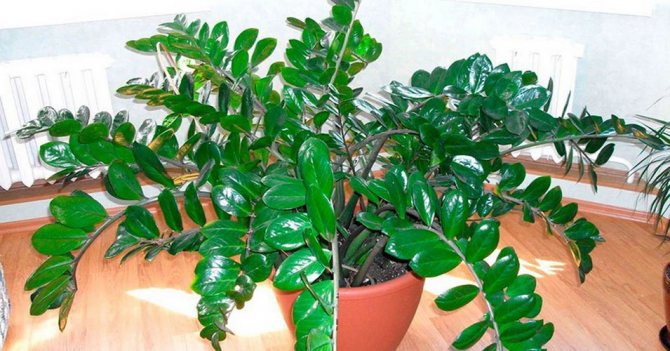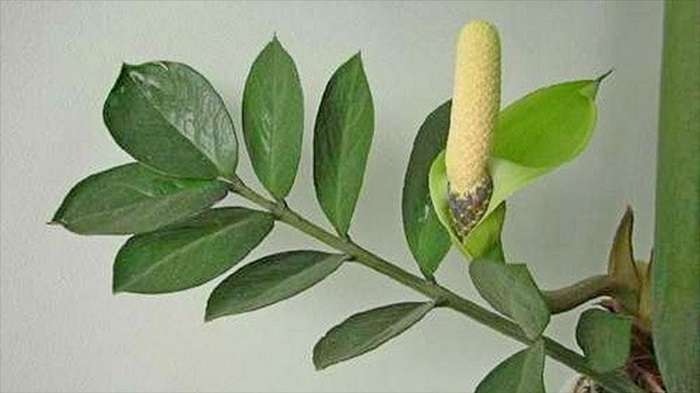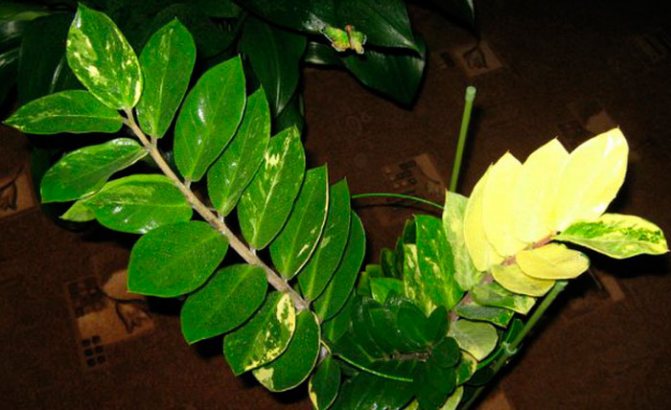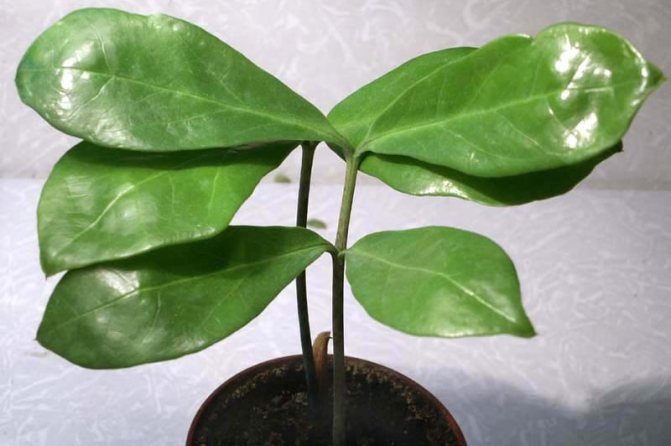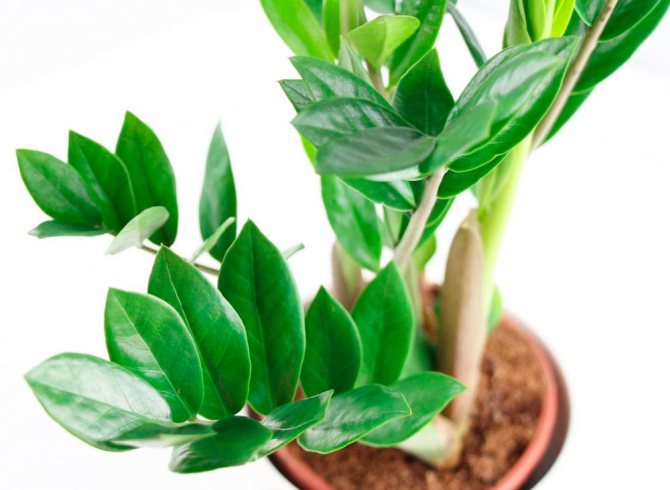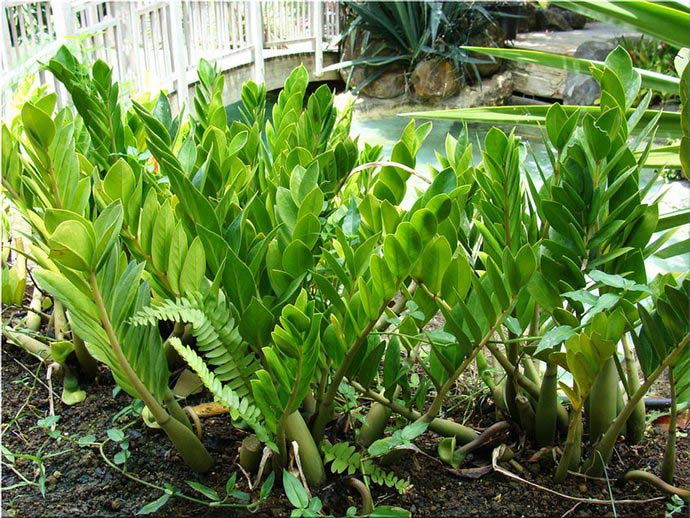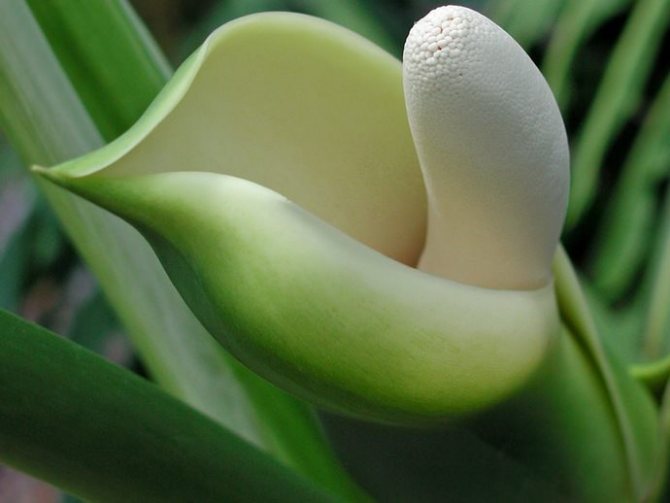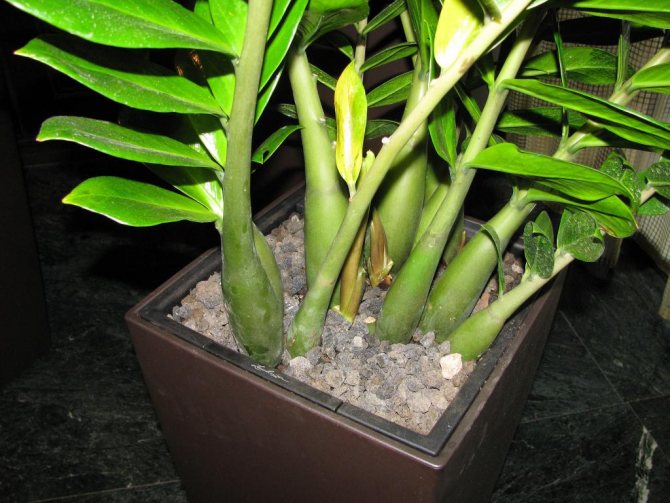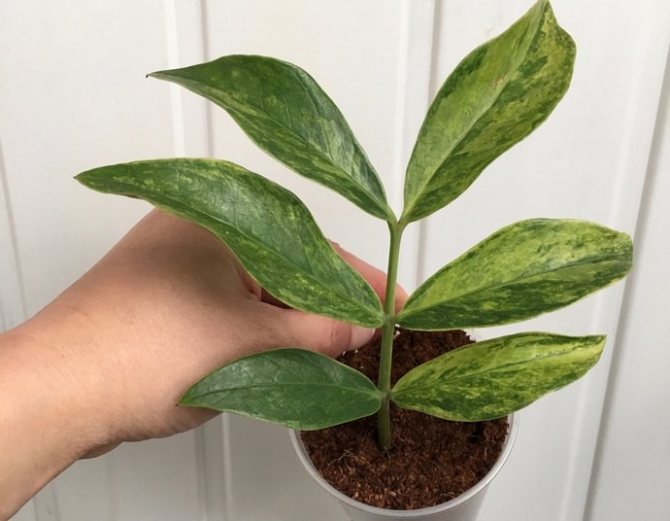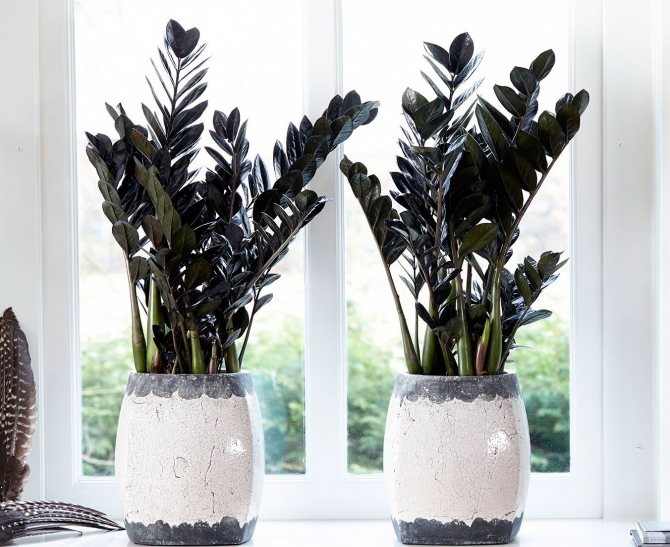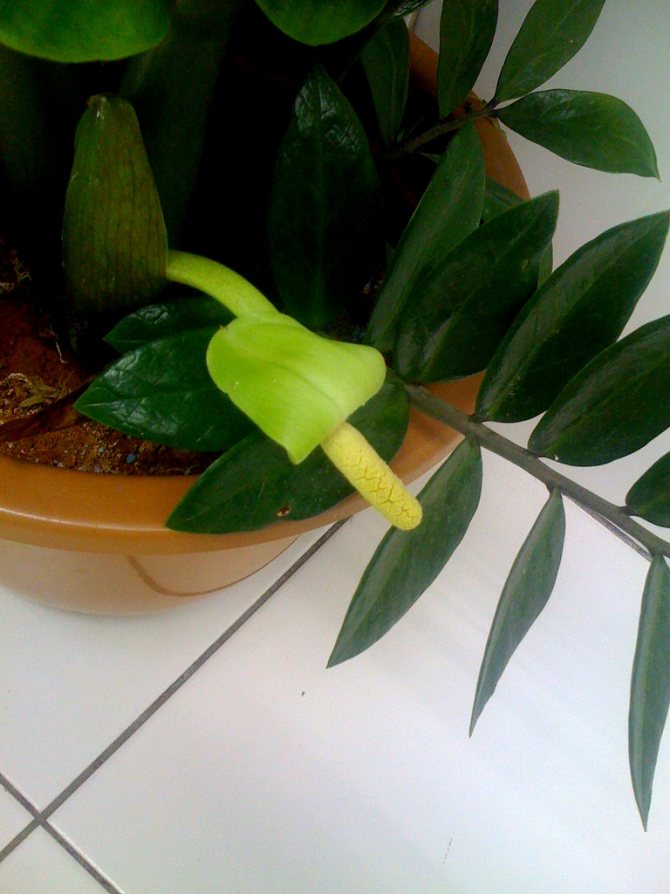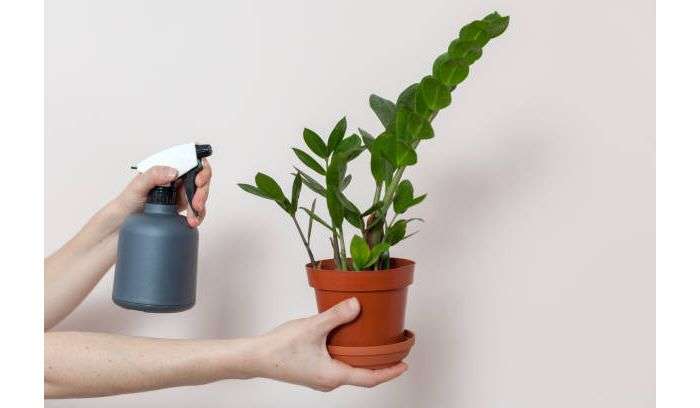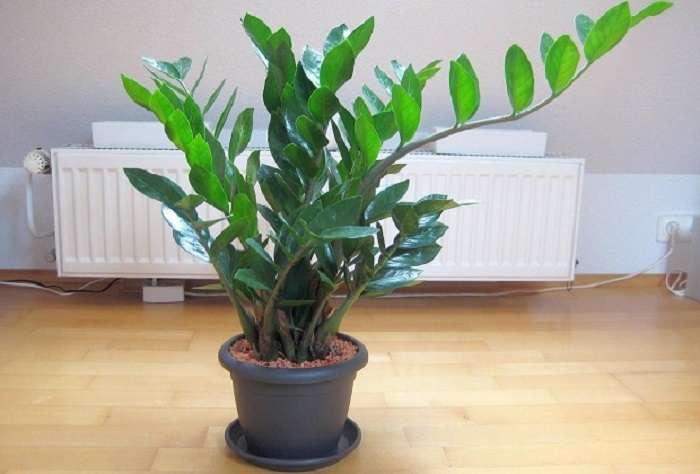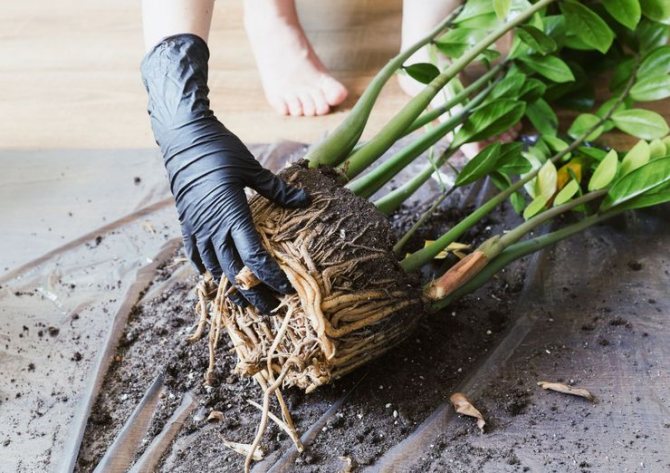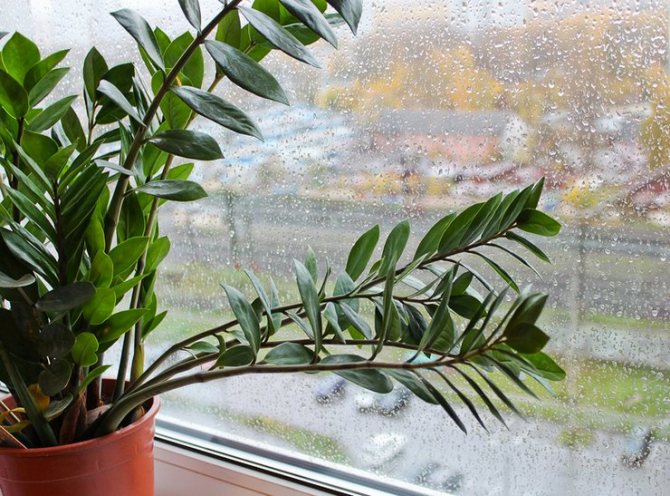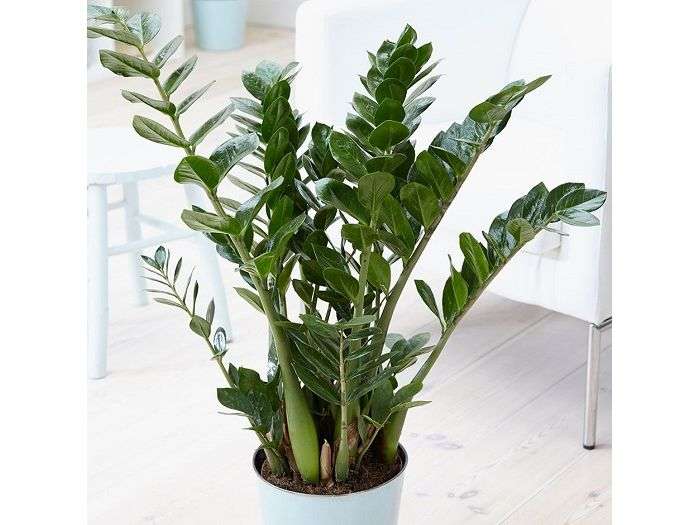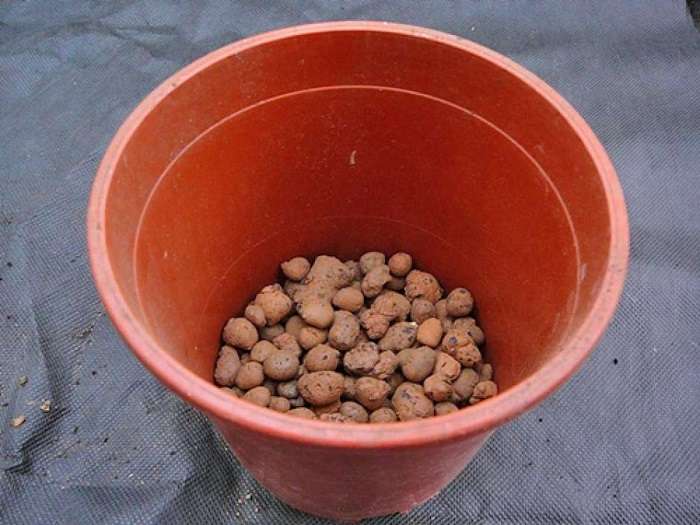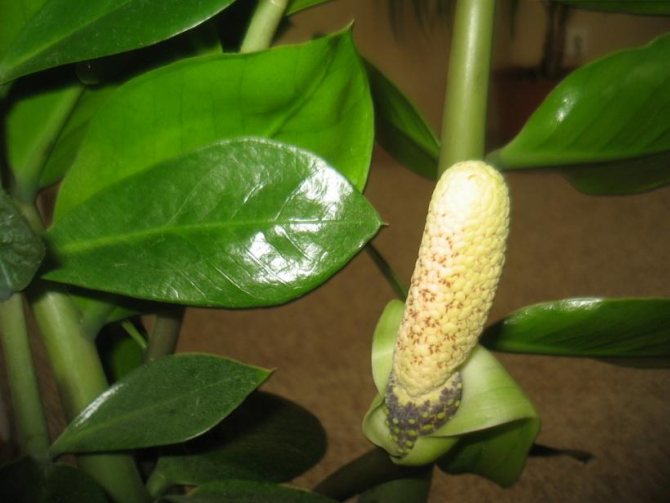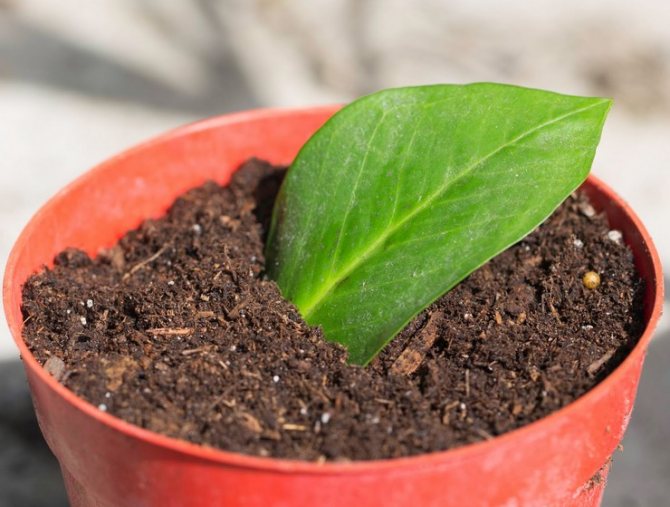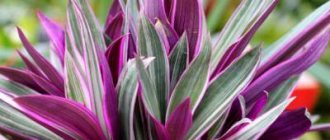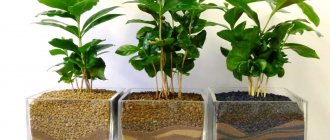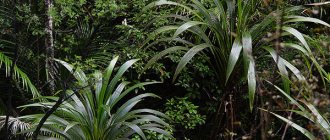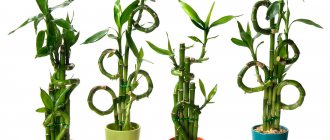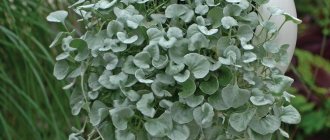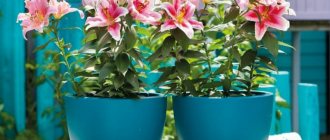Zamioculcas is a perennial evergreen plant belonging to the aroid. The homeland of this plant is in East Africa, or rather it is the Zanzibar plateau. It came to Europe only at the end of the twentieth century from Dutch nurseries and immediately gained immense popularity among flower growers, thanks to its unusual exotic appearance.
Zamioculcas belongs to succulent plants. It has very beautiful complex leaves, consisting of leathery glossy leaf plates, which are arranged in pairs. The rhizome is the tuber from which the cuttings emerge.
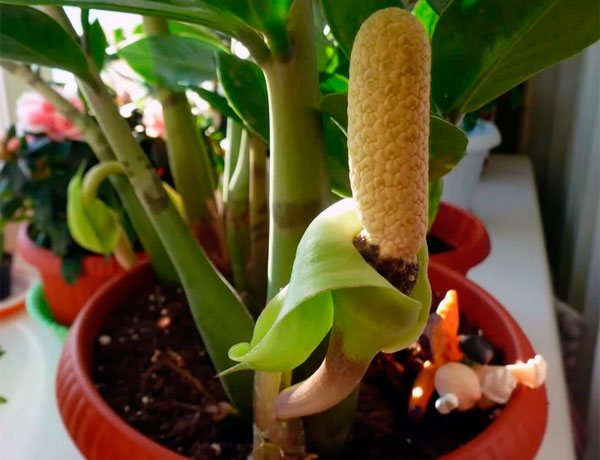
Plant height can reach from sixty centimeters to one and a half meters. The flowers of the plant are of a rather interesting shape, consisting of a fairly large lime cob, and the surrounding bedspread of the same color. You can find out what a dollar tree looks like from the photo accompanying this description.
Zamioculcas is the scientific name for a flower popularly known as the dollar tree... It is not known for certain where this name came from. Some believe that because of the color of the leaves, reminiscent of new dollar bills, others because of the high cost or because of its ability to attract money into the house in this particular currency unit.
Zamioculcas is also called the flower of female happiness. According to signs, if it blooms in indoor conditions, which does not happen often, then its mistress will find real female happiness. Although many people do not know why they believe that zamioculcas is a celibate flower. How zamioculcas blooms is shown in the first photo in this article.
Also called:
- Zanzibar pearl or Zanzibar gem - in the place of growth;
- Fat man - because of the peculiar appearance;
- An eternal tree - due to its very slow growth.
Zamioculcas is very popular in China, where, according to the Feng Shui theory, the dollar tree indoor flower is a talisman that brings good luck and wealth to the house, especially if you bury a few coins in the pot where it grows. It is called the plant of the Chinese New Year.
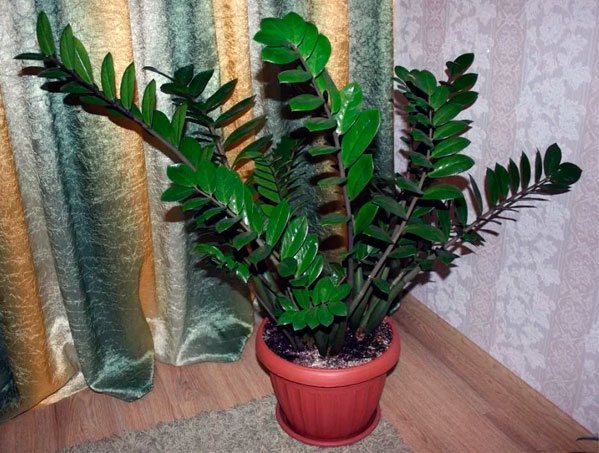

Zamioculcas zamielistny - the only species of this plant... It is also called the Zamioculcas of Loddjes, after the name of the man who first discovered it in 1856. Currently, due to the enormous popularity of this plant, breeders are actively working to create new varieties of it.
The dollar tree propagates by dividing the rhizome, by rooting a whole leaf (branch) or leaf blades.
Popular types
Zamiokulkas appeared in flower shops 20 years ago. During this time, breeders have bred several different species, the most popular of which for home cultivation are:
Zamioculcas Zamiifolia
This is the most typical representative of the plant. It belongs to the "money tree". A beautiful ornamental bush with bright fleshy leaves. The plant looks so perfect that it feels like it is artificial. An amazing plant that hides its trunk in the soil. For the first time weeks after growth, the flower does not form roots. Instead, a tuber that stores large reserves of water. The tuber is somewhat reminiscent of a dark marsh or brown potato. It has the shape of an ellipse.
Looking at a pot with a plant, it seems that bright green leaves are growing directly from the soil. The leaves are attached to the tuber with a long handle, which unknowing flower growers take for the trunk. The length of the leaves reaches 60 centimeters. The leaves grow from the tuber and are divided into 8-12 separate feathers. This is very rare for this species. The feather is dense, glossy, has a thick, juicy axis in which the flower stores moisture.
The plant grows very slowly in height. The cost of a shrub in a flower shop depends on its growth, the longer, the more expensive.


Zamioculcas zamielistny / Flowering
Zamioculcas variegate (Zamioculcas variegate)
Variegated or variegated zamioculcas are very difficult to find in flower shops. His homeland is the island of Madagascar. At home, it can reach a height of 1 to 1.5 meters. The leaves are arranged symmetrically in strict order. They have a bright green color, juicy flesh, pointed at the tips. Flowers rarely appear in the plant, with very good care. The inflorescence is formed in the form of an ear.


Zamioculcas variegated
Lanceolate Zamioculcas (Zamioculcas Lanceolata)
Received this name because of the elongated leaves of the original lanceolate shape. The flower was first exhibited at flower auctions in Holland at the end of the 20th century. Its height reached 1.5 meters and more. In 2007, a miniature plant was bred, not exceeding 60 centimeters in height. Its leaves are an exact copy of the progenitor, only in a reduced size.


Zamioculcas lanceolate
Black Zamioculcas Blak
The plant has almost black leaves and cuttings. Otherwise, it is completely similar to zamioculcas zamifolia. The same fleshy leaves pointed at the tips, fixed symmetrically on both sides on a common cutting. The young bush has lettuce-colored leaves. As they grow older, they begin to darken. At the same time, their color is completely unaffected by the lighting in the room. No matter how the florist tries to lighten the leaves, he will fail. This "tree" looks very impressive. Therefore, it will perfectly decorate any room.
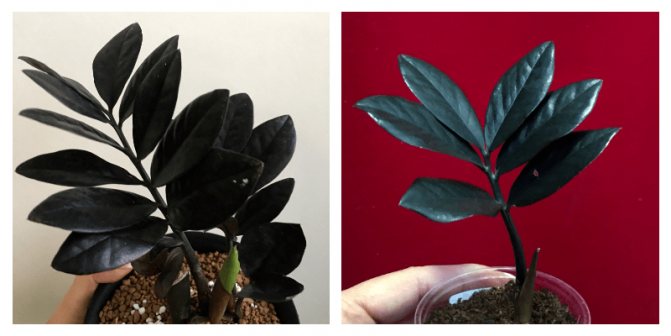

Black zamioculcas
Homeland and botanical characteristics of Zamiokulkas
The homeland of the plant is Madagascar, where in nature this evergreen plant is widespread. Under natural conditions of growth, "currency trees" grow and develop magnificently in arid soil, under the hot rays of the scorching sun, but in our latitudes the plant feels quite comfortable. In indoor culture, the monotypic genus is represented by a single species - zamioculcas zamyelistny. Indoor zamioculcas have glossy dark green leaves of regular shape.
Ornamental culture does not form branches, and what many growers mistake for the stem is actually complex foliage growing directly from the tuber. There are thickened petioles at the base of the leaves. The foliage is located on a fairly short, horizontally located, false stem part. The growth and development of the aerial part is rather slow. The so-called stem part of the zamiokulkas is thick, erect, fleshy, and stores moisture reserves at the base.
Care
The plant does not require careful constant attention. Growing a healthy dollar tree is not difficult. In its natural habitat, the flower is accustomed to difficult growing conditions. Therefore, he is not at all capricious in the care, location and choice of soil.
Watering
The health of the currency tree depends on proper watering. The plant is able to accumulate liquid, so it tolerates drought more easily than excess moisture. Excessive moisture causes tubers to rot. The lack of moisture is visible in the thinning of the leaves, their sluggish form.With prolonged drought, the flower can shed its leaves, especially during the period of intensive growth.
The following watering pattern should be followed:
- Spring and summer is the growth period of the plant. Therefore, the flower needs extra moisture. Watering is carried out 3-4 times a month;
- Winter and autumn refer to the dormant period when the plant is resting. It is necessary to reduce the frequency of watering to 1-2 times a month.
For irrigation, settled water at room temperature is suitable. Make sure the soil is completely dry before moistening the soil. If excess water has flowed out into the pan, it must be drained immediately. With its stagnation, putrefactive processes begin.
Lighting
This is a light-loving plant. Brilliantly brings blackout though. The best location is the south window sill. Do not expose the flower to direct sunlight, as the leaves can get severe burns.
- It is worth hanging a small curtain over the window to create a slight oppression, especially during the summer season.
- In the absence of good lighting, the leaves of the dollar tree become thinner. They become slightly lethargic, and the shrub loses all its decorative charm.
- It is especially important to create bright lighting during the period of increased plant growth: in spring and summer. In order for the growth to be uniform, you need to turn the flower to the window on different sides, otherwise the symmetrical shape of the arrangement of the leaves will be absent.
The plant loves fresh air. Therefore, in the warm season, it should be taken out into the garden or on the balcony. First, it is necessary to provide the eternal tree with a slight darkening and protection from atmospheric precipitation.
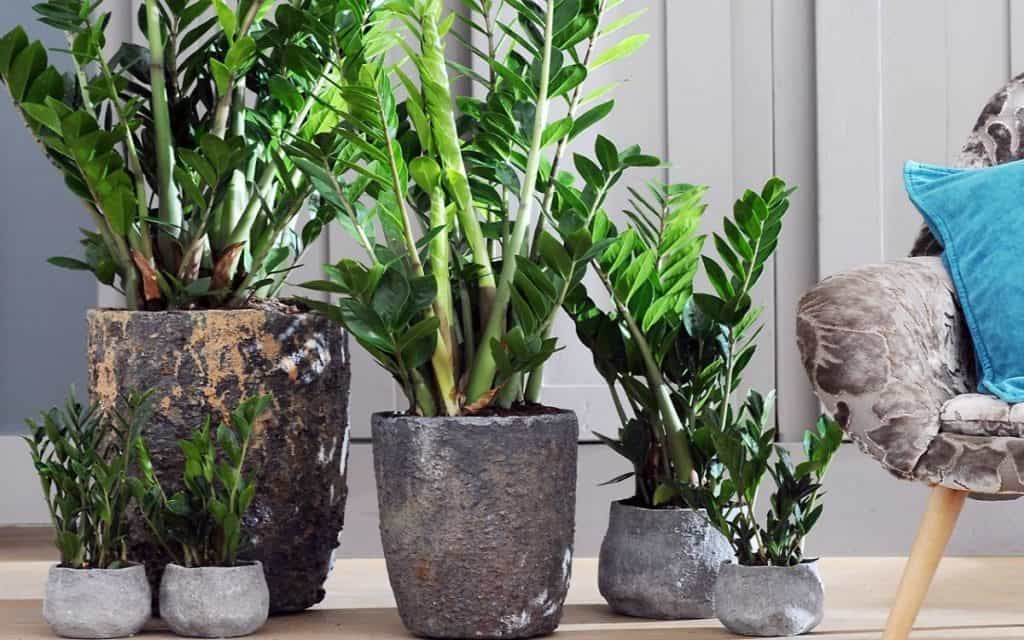

Temperature
The plant is native to Africa, so it loves warmth very much. Intense heat, exceeding the thirty-degree mark, will not bring any harm to the shrub. Experts engaged in breeding zamiokulkas believe that the optimum temperature for the normal growth and development of a plant is from 22 to 26 degrees. A drop in temperature in winter to 16 degrees will not harm the shrub at all. It should be noted that if the air temperature drops below 12 degrees, the plant may die. Sudden temperature jumps are also harmful to him.
The dollar tree doesn't like drafts.
Humidity
The flower tolerates dry air perfectly. Spraying the plant with water is not an urgent need. It should be carried out when dust has accumulated on the leaves, which will be much more convenient to remove.
Only warm water is sprayed. Then the leaves are gently wiped with a damp soft cloth. Most often, such a "cleaning" should be carried out in the summer.
The soil
The soil for the plant should be loose and light, capable of passing moisture and air well. In flower shops, special formulations are sold specifically for succulents.
You can prepare the soil yourself. You will need the following components:
- Sod land;
- Leafy land;
- Peat;
- Sand.
All components are taken in equal proportions and thoroughly mixed. Florists advise adding a little sphagnum moss to this composition. The Zanzibar pearl does not like acidic soil, so the acidity of the soil should be neutral.
The soil must be disinfected before use. To do this, it is warmed up in a water bath for 10-15 minutes. You can also spill the soil with special chemical compounds or a weak solution of manganese. Some growers spill the soil with boiling water.


Transfer
Zamioculcas is a slow growing plant. Therefore, he will not need frequent transplants. A young flower is transplanted once every two years. For a mature shrub, a transplant is sufficient once every five years.
Care must be taken. The flower does not tolerate even a large damage to the tubers.In order not to injure the money tree, it is transplanted while preserving the old soil. A complete replacement of the soil is possible only if the plant is sick or if it needs to be separated.
For a flower, it is better to choose a clay stable pot. The transplant is carried out according to the following instructions:
- Using a flat wide tool, carefully remove the plant from the old pot along with the soil.
- The drainage is placed in the new container. Do not add coins to it. Such superstition can lead to oxidative processes that harm the tuber of the plant;
- The drainage is lightly covered with new soil;
- The plant is clearly located in the middle of the new pot and sprinkled with soil on all sides. It is impossible to deeply deepen the tuber, it should rise slightly above the surface.
- The plant is watered with a little water.
After transplantation, the currency tree does not require any special care. It is put in its original place. You can plant a plant only by dividing the tuber into two or more parts. This is a painful procedure. Therefore, if such a method of flower reproduction is not planned, then it is better to transplant the tuber as a whole.
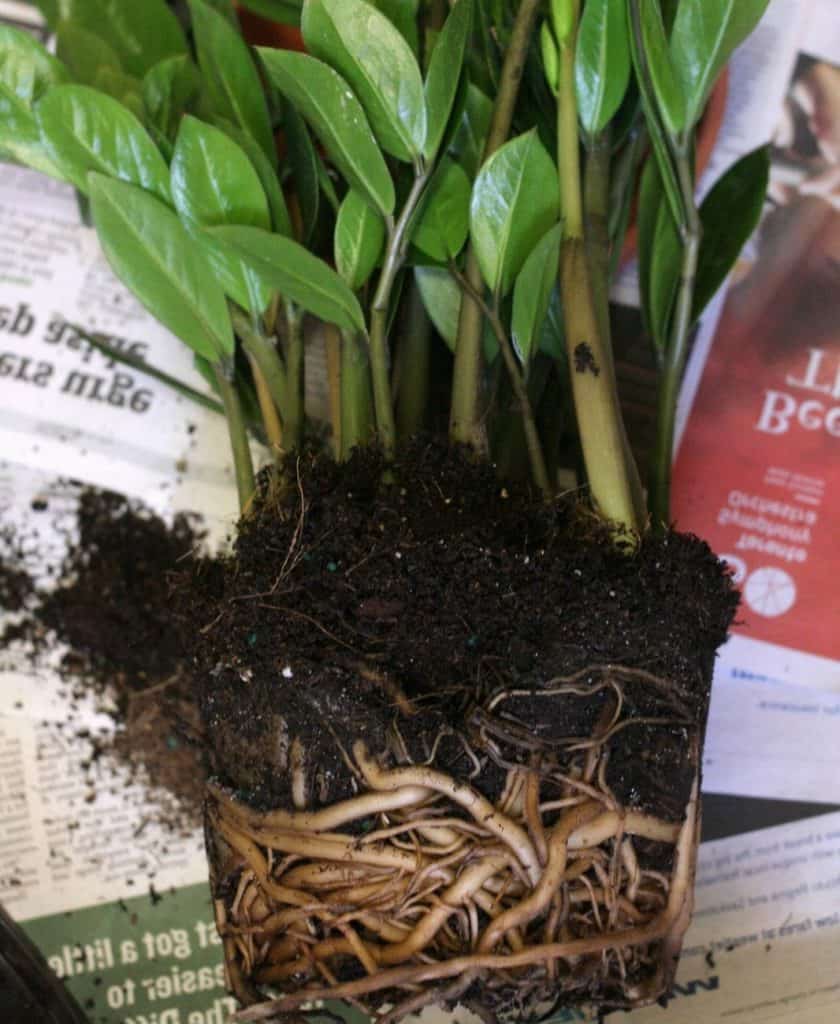

Fertilizer
It is best to buy special food in the store. For indoor plants, it is divorced in half with water. Especially the flower needs fertilization during the period of active growth and flowering, that is, from April to October.
During dormancy, do not fertilize the plant.
In addition to horse feeding, you can use foliar. It is held in the spring and summer period no more than 1-2 times a month. For this, the leaves of the plant are sprayed with a solution of urea. The procedure is carried out between waterings.
Caring for the dollar tree at home


Illumination
Zamioculcas tolerates direct rays of the sun well, therefore it can be placed on a south-facing window. However, in the summer, when there is a lack of fresh air at midday, the plant is recommended to be shaded. It also grows and develops normally on light windowsills of western or eastern orientation. A flower recently purchased from a store is gradually accustomed to direct sunlight, otherwise burns may form on the surface of the foliage. The same is done after prolonged cloudy weather.
Temperature regime
In spring, summer and autumn, the plant needs warmth (from 22 to 25 degrees). In winter, it is moved to a cooler place (about 16 degrees). The room in which the flower is located must be systematically ventilated.
Watering


From spring to the end of autumn, watering the dollar tree is carried out only after the soil mixture in the pot is half dry. The rest of the time, watering should be more scarce and less frequent. The same watering regime is necessary for the flower in case of prolonged cloudy weather. If the room is cooler than necessary, then the substrate is moistened only after it is completely dry. During prolonged drought, the upper part of the leaf blades dries up.
Water the flower with soft and well-settled water (at least 24 hours). Make sure that the liquid does not stagnate in the root system of the plant throughout the year.
Air humidity
A dollar tree grown indoors grows well at low air humidity, which is typical for living rooms. In this regard, it is not necessary to moisturize the foliage. However, on hot summer days, it is recommended to regularly wipe the leaves with a damp sponge or spray with warm water from a spray bottle.
Bloom
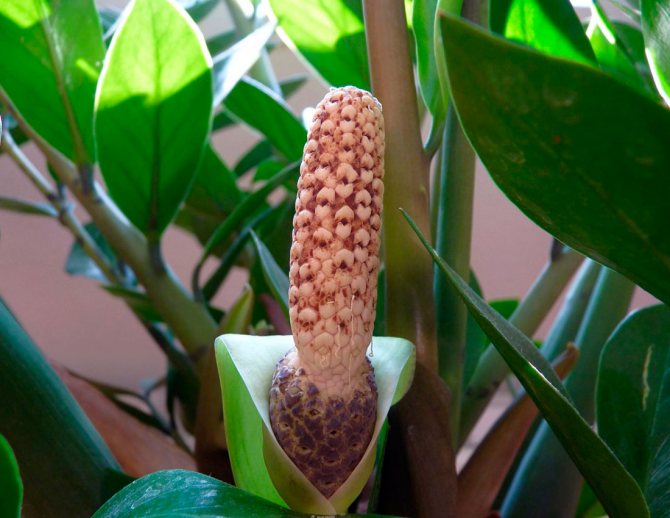

Only a well-developed plant can bloom in indoor conditions. He has an inflorescence-cob on a short peduncle, which is covered from above with an apical pale green leaf.
Fertilizer
Top dressing is carried out from the second half of spring to autumn, the flower is fed once every 2 weeks, for this, fertilizer is used for cacti or succulents. The rest of the time, feeding is not carried out only if the weather is cloudy.
Garter
In a grown bush, large leaf plates need to be propped up; for this, a special support with rings is used. If this is not done, then the leaves begin to fall over.
Zamiokulkas transplant
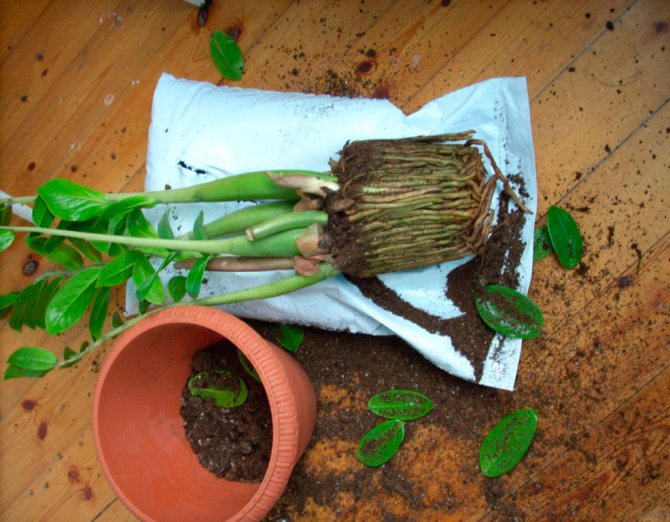

A transplant is recommended only if necessary in the spring or summer. As a rule, it is done once every 2–4 years. With rare transplants, the growth of the bush can be slowed down. It is recommended to use a tall clay pot for transplanting. If the container is taken too wide, then at first the development of the root system will occur, and at the same time the growth of the aerial part will greatly slow down. And in a pot that is too large, there is a possibility of liquid stagnation in the soil mixture. For transplantation, a substrate of the following composition is used: sand, garden, vegetable and forest soil (5: 2: 2: 2). You can also add a small amount of charcoal to the finished soil mixture. Do not forget to make a good drainage layer at the bottom of the pot, which should occupy at least ¼ of the container.
Reproduction
This plant can be propagated by dividing and rooting leaves and leaf blades. For rooting, a mini-greenhouse is used, which is filled with a mixture of peat and sand, while the air temperature should be above 20 degrees.
Nodules may form at the base of the leaves that have flown around. They can be used for reproduction, over time they will develop roots and kidneys. If development proceeds normally, then the first stem can form after six months.
Diseases and pests
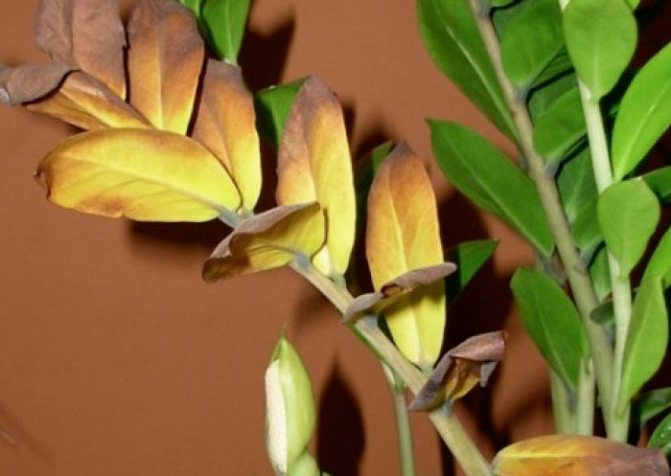

With improper care, zamioculcas may have problems. For example:
- Leaf plates die off... If there is mechanical damage on the foliage, this can lead to their death.
- The plant is stretched... This is due to too poor lighting.
- Flying around foliage... If the lower leaf plates die off and fly around, then this is a completely natural process.
- Specks on the leaves... Dark spots form on the foliage, this can happen due to drafts, excessive watering and cold air.
- Rot appeared on the bush... Rot can appear on the roots and shoots if the room is too cold, and water stagnation is regularly observed in the substrate.
- Harmful insects... This plant is highly resistant to pests, but scale insects or aphids can settle on it.
Reproduction
In flower shops, the plant is expensive. It will not be difficult to breed it at home. There are three known methods for breeding zamiokulkas:
- Separation of the tuber.
- Cuttings.
- Reproduction by a sheet.
Each method has its own characteristic features:
Splitting the tuber
This method of flower reproduction is possible in the presence of a large maternal tuber. It is necessary to remove the tuber from the pot and remove all the soil. There are buds on the rhizome, from which lateral shoots can form in the future.
A tuber on which only one bud cannot be divided. The separation is carried out with a sharpened disinfected knife. The tuber should be cut lengthwise so that there are several buds on each side. The cut is sprinkled with crushed black activated carbon sand.
After 2-3 hours, the plant can be planted in a prepared pot. If there is no lateral shoot growth point on a part of the rhizome, the plant will die.


Cuttings
This is the most acceptable method for reproduction of zamiokulkas. Cutting is suitable for mature plants with several lateral shoots.
The larger the stalk, the more likely it is to grow a full flower from it.A lot of nutrients are stored in the cuttings, contributing to faster rooting than with leaf propagation.
The stalk is a process of the zamiokulkas, on which at least one kidney is present.
Cutting goes through the following stages:
- We choose the most suitable part of the plant for this;
- We cut it off with a scalpel or a sharply sharpened knife. The instrument must be sterile;
- Pour warm water with a small amount of activated or charcoal into the container;
- We place the process with the cut down in the container;
- We are waiting for the formation of roots;
- We plant it in a pot.
For germination, it is necessary to observe a temperature regime of at least 20-22 degrees and keep the shoot in good lighting. The water is constantly refreshed, otherwise the stalk may rot.
You can carry out cuttings in another way. For this, the cut of the appendage is processed with charcoal. After a few hours, a special cork forms at the cut site, which will not allow the plant to rot. It can now be placed in the moist soil of the pot, so that the bottom of the bud is covered with soil and the top remains on the surface.
For a transplanted plant, you can make a small greenhouse, then rooting will go faster. When watering, the main thing is not to hit the bud, otherwise the plant may die.
In order to see the formation of roots, planting is best done in a transparent container - a plastic bottle or glass. Drainage holes should be made in them with a sharp tool. After the formation of the roots, the plant must be transplanted to a permanent place.
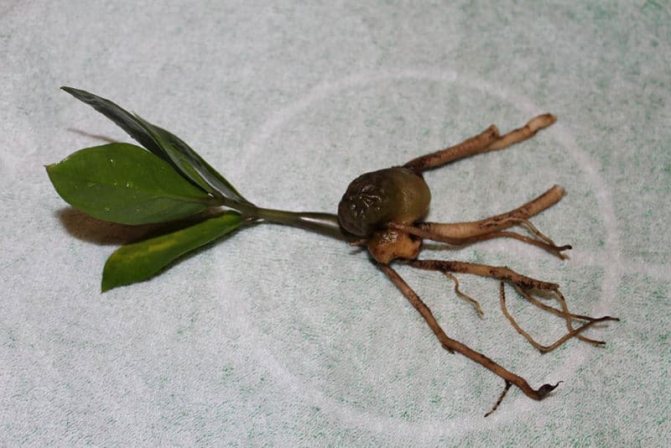

Leaf propagation
The plant can reproduce with a whole leaf or leaf plates. The process of obtaining a tuber from a leaf can take up to six months. It all depends on the planting material. The more you can take the leaf, the faster the tuber will form.
If a whole leaf is used for breeding, its lower parts should be removed. It is placed in warm water in a well-lit, warm place. The water changes every other day. When the first roots appear, the sheet can be immediately planted in a prepared container.
It should be noted that with direct sunlight or stagnant water, the leaf will die.
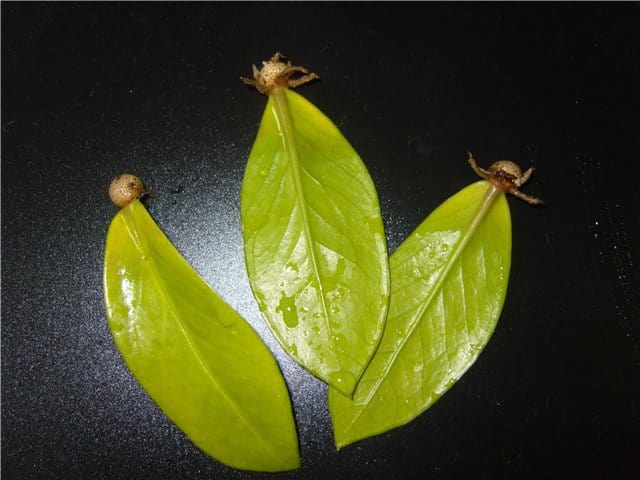

Zamioculcas - exotic in the house
The homeland of this handsome man is Tanzania, a small country in the east of Africa. Initially growing in arid regions with a lack of moisture, Zamiokulkas feels great in an ordinary apartment or office.
Zamioculcas will harmoniously fit into any interior
Zamioculcas belongs to the succulent plants of the Aroid family. Its stems are straight and fleshy, with dark green shiny spear-shaped leaves.
Perhaps it is precisely because of the similarity with the palm tree among the people that it is known by such names as the aroid palm, the Zanzibar pearl, the emerald palm, and more familiar to us - the dollar tree.
In the homeland of the plant, in East Africa, it constantly blooms with yellow-orange or green-white flowers, but in the conditions of ordinary apartments, flowering can only be achieved in adult plants. Zamioculcas reaches 80 cm in height, but grows rather slowly at a young age. On the roots, tubers are formed in which nutrients accumulate, so the plant can easily endure the dry periods of its life.
Dollar tree or flower of celibacy - myths and omens
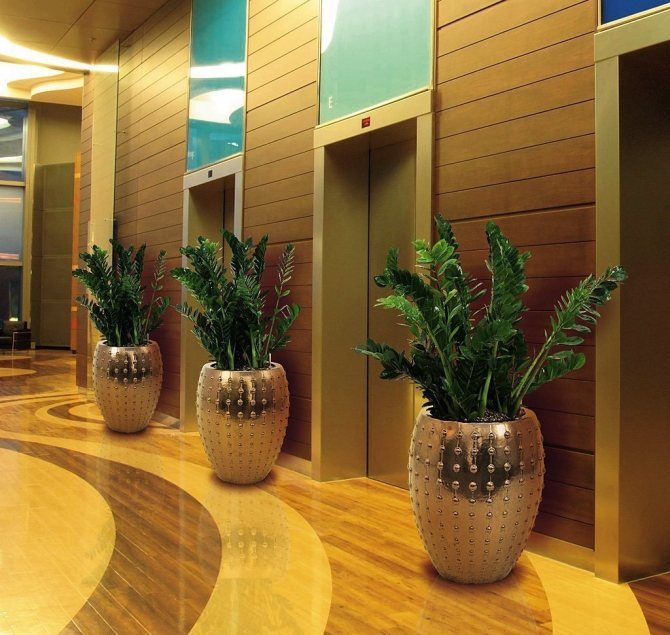

Zamioculcas is considered a symbol of well-being and prosperity
Zamioculcas will get along well with both an amateur beginner and a professional florist. Large pots of powerful plants adorn spacious offices, greening the office space and adding a touch of comfort to them, in recent years it has become very popular.
One of the reasons for this success is the sign that zamioculcas brings money to the house, it is even called the dollar tree. Of course, you cannot find dollars on it, but it is believed that a well-growing flower in the house, with lush foliage and rich color of leaves, increases the well-being of the family. To do this, the shoot (or rhizome) of the zamiokulkas must be taken from successful or rich people, giving in return a coin of small denomination.
However, like almost any succulent, zamioculcas is considered a celibate flower. Having him in the house negates the possibility of getting married for an unmarried girl. Whether it is true or not is up to you, but if you are inclined to believe superstitions, but you still want a flower, then ask your friends to buy it as a gift, and when you present the flower, hand the donor a small coin - then the negative energy of the flower will be neutralized.
Conditions of detention in the apartment - table
| Parameter | Autumn winter | Spring Summer |
| Lighting | Bright light, better east or west window, but can grow in partial shade | |
| Temperature regime | Not lower than + 15 ... + 18 оС | + 25 ... + 30 ° C and above |
| Watering | After complete drying of the soil, moderate | Abundant, let the substrate dry, do not overfill. |
| Air humidity | It is advisable to periodically spray | |
Pruning
Pruning is not a prerequisite for proper plant care. It is carried out only to give it a certain shape or rejuvenation. You can trim any parts of the plant: tuber, leaves, cuttings. The main thing is that the cutting tool is very sharp and sterile. A scalpel, garden pruner, or a sharp knife will do.
The place of the cut must be sprinkled with crushed activated carbon. This will allow you to quickly stop sap flow and close the access to the "wound" for pathogens. Pruning is often used to heal the currency tree.
How to plant indoor zamioculcas
Prepare drainage for the pot before planting the plant. It can be expanded clay, small river pebbles and polystyrene. It needs to be laid three quarters at the bottom of the pot. For successful rooting of a plant, ready-made soils for violets or cacti are well suited, they are excellent for air and moisture. If you take soil from a garden, it needs to be decontaminated. When planting with a handle, it can also be rooted in water, in a disposable cup. The seedling is placed in a warm place with diffused lighting at + 22 ° C. If rooting in the ground, water regularly. It is important not to overflow - weak roots will rot from excess moisture. When planting a plant with tubers, make sure that the tubers are slightly peeking out of the soil.
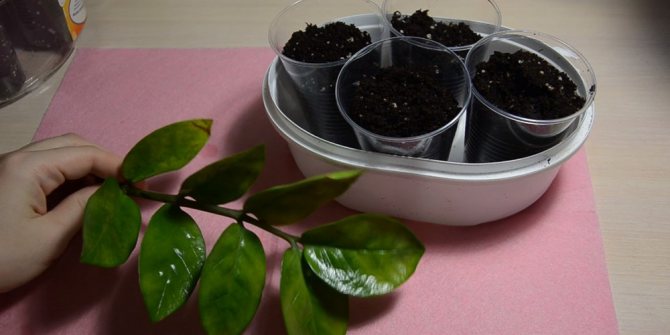

Diseases and pests
The flower is very resistant to various diseases. Therefore, it practically does not get sick and is not affected by pests.
Improper care may not bring it to a painful state. The most common cause is over-watering. In zamioculcas, the root system begins to rot. In this situation, the flower requires an urgent transplant. It is necessary to inspect the rhizome, remove all putrefactive damage.
If the leaves of a currency tree turn yellow, this does not indicate its illness. This is the normal growth process. Old leaves die off and turn yellow, replaced by new green leaves. Yellowed leaves are removed only after complete wilting with a sharp instrument.
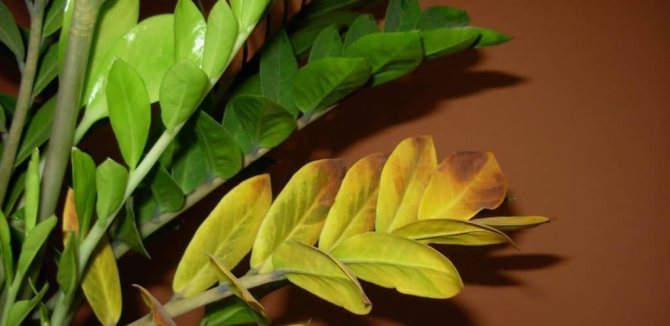

Why does not it grow
Sometimes it seems to the owner that the plant practically does not grow, and at the same time there are yellowed leaves. In this situation, you need to check the temperature regime, the presence of drafts and pests. It is possible that the breeder forgot to water the plant at the time.
Slow growth is the hallmark of this plant. Don't try to add more fertilizer or watering. If new shoots do not appear for a long time, it is worth revising the location of the money tree and paying attention to the water with which the plant is watered. It should be clean and warm.
Bloom
Rarely does a gardener manage to see the flowers of this ornamental plant. But, this does not mean poor flower care, since the appearance of flowers in zamiokulkas, even at home, is a rare phenomenon.
The inflorescences have an unusual appearance of the cob, in which the female and male flowers are located on opposite sides and are separated by a number of sterile flowers. Inflorescences appear at the bottom of the plant, at a distance of 20 centimeters from the ground. This arrangement does not make self-pollination possible. Pollination is carried out by small insects and the wind.
In place of the faded flowers, small berries filled with seeds appear. It is impossible to get a ripe fruit at home. Experienced plant breeders argue that the period of appearance of the first flowers is largely dependent on the location of the plant. So, if you put it on the "northern" windowsill, flowers appear by the end of the life of the dollar tree. The choice of the "southern" window promotes whiter early flowering.


Features of zamiokulkas
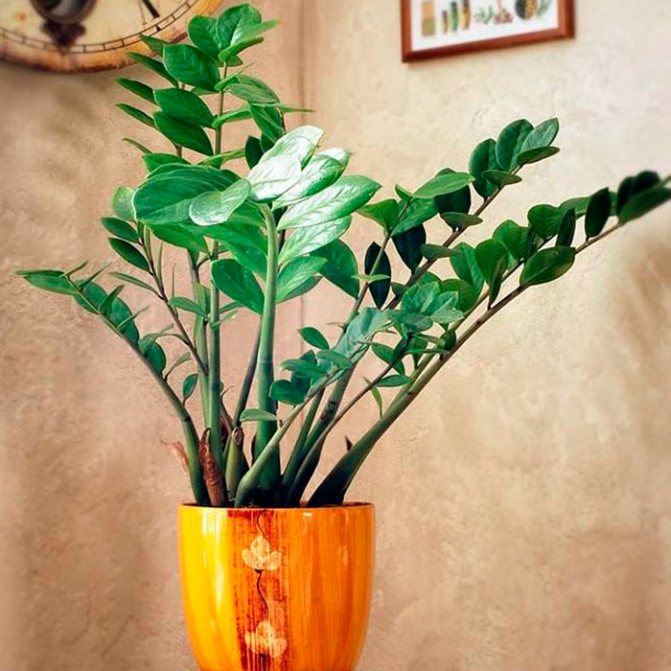

Zamioculcas is a low herbaceous plant. Its rhizome is tuberous, and the roots are thick and fleshy. A thick and juicy rachis is very necessary for a flower, as it stores water in it. Feathers leathery to the touch are quite dense. The length of the leaf plate can reach about 100 cm.During a long dry period, the plant throws off the leaves from the upper part of the leaf plate, due to this, moisture evaporation decreases, and from below the petiole is needed to preserve liquid for the bush. The accumulation of moisture also occurs in the underground tuber. A well-grown bush can begin to bloom when grown at home. A short, thick peduncle emerges from the base of the leaves, it bears an ear-inflorescence of a pale cream color.
Signs and superstitions associated with the plant
Now it is difficult to find the origins of the popular name of the plant. Why did it come to be called a "currency tree" and every banking institution always has it in the reception area.
A huge number of superstitions and signs are associated with this bush, especially regarding female happiness. For example, one of its popular names - "flower of celibacy", indicates that a young girl who has such a decor in her house will never receive a marriage proposal. But there are some deviations in this myth. If a girl bought a flower herself, then she will not see female happiness, but if she was presented with it, luck in amorous affairs is guaranteed. In this case, the flowering of the plant is considered a special success. This indicates that the wedding is just around the corner.
- It is important to give the shrub on a special day, such as New Years, Christmas or birthday. It is believed that he will bring great luck and rapid career growth, which will lead to an increase in material wealth.
- The presence of a flower in the home is associated with the addition of health and well-being. But for this, the plant needs to be loved, as it feels the energy emitted by its owners. For a kind attitude, the plant emits positive radiation.
- The given shrub must be immediately transplanted into another pot. This will ensure the flow of money. In this case, it is imperative to bury coins in the ground. This will help the shrubbery "tune in" to the radiation of monetary energy.
- Any growth of the plant, the formation of cobs is regarded as an indication of imminent financial well-being. In this case, the receipt of funds must be in dollars.
The money tree is a very beautiful ornamental plant. When caring for it, transplanting or pruning, do not forget about its poisonous juice. Therefore, all work is carried out with gloves. If there are small children in the house, then it is worth putting the flower at a height that is not accessible to them. If properly cared for, the plant will share its positive energy and bring prosperity and well-being to the house.
History of room culture zamioculcas
The first description of zamiokulkas dates back to 1828, and was given by the very famous foreign collector of tropical crops Konrad Lodijes. The plant has been described as Caladium zamiifolium Lodd. More than twenty years later, Heinrich Wilhelm Shote changed this name to Zamioculkas Loddjes. And a few decades later, the modern, latest and best-known version of the name Zamioculcas zamiifolia was registered by the director of the Berlin botanical garden, Adolf Engler.
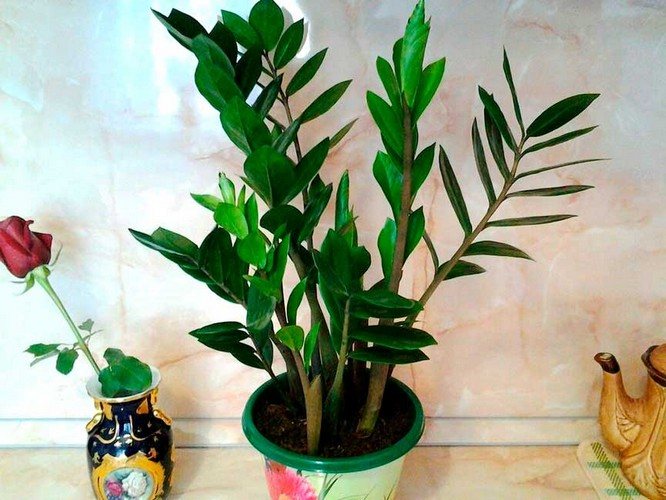

This evergreen tropical plant became popular as an ornamental indoor culture twenty years ago, after appearing at foreign flower auctions. Ten years ago, the first miniature stump of zamioculcas var was obtained, forming a very compact plant no more than 0.5 m in height with rather small but attractive foliage.
